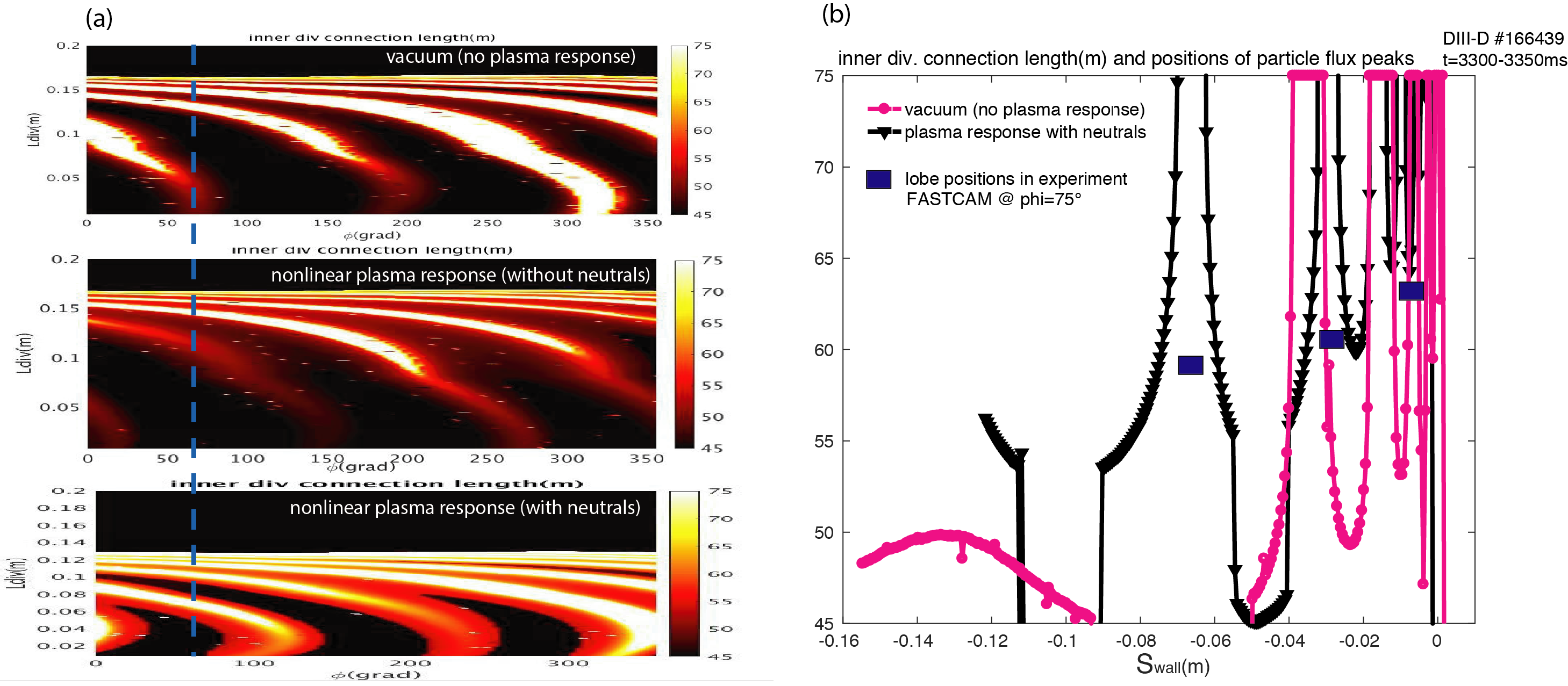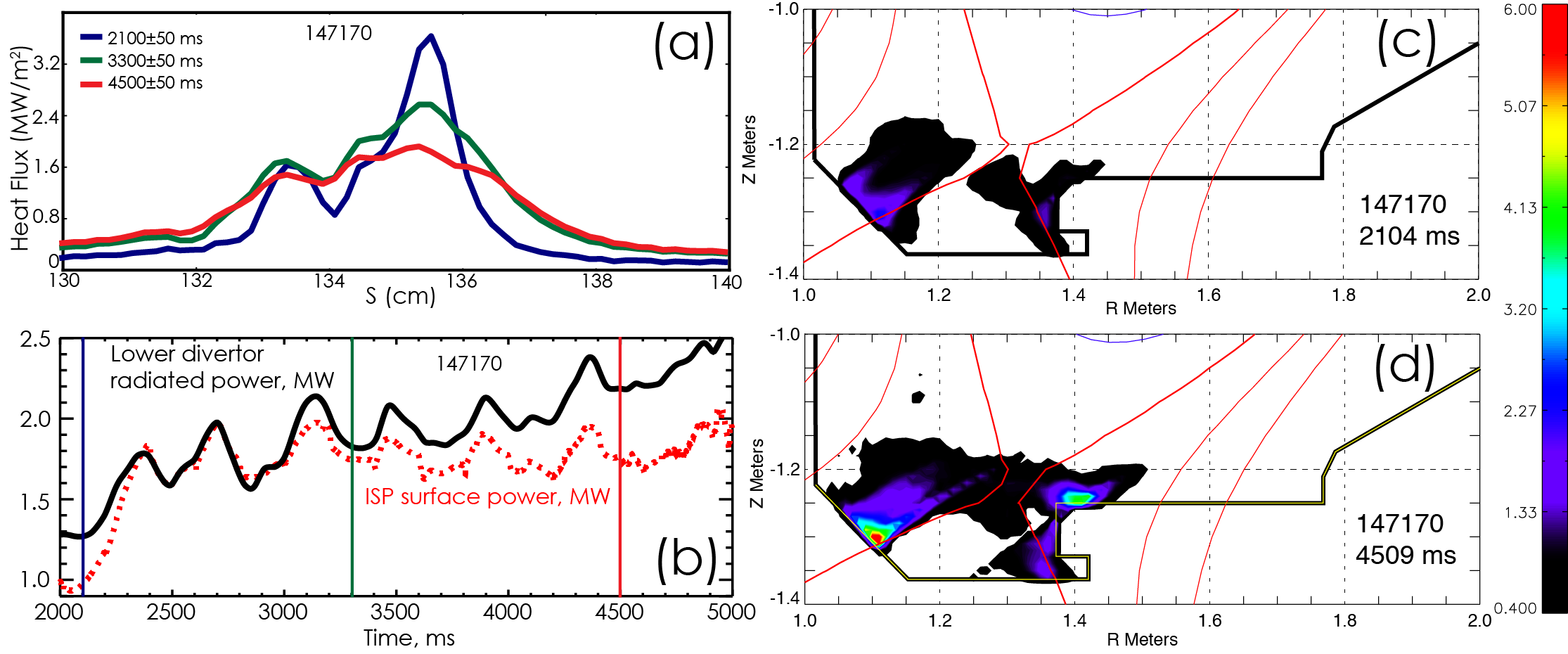Speaker
Description
In this work we show that nonlinear MHD plasma response simulations are essential for understanding and predicting accurate heat and particle flux striations in DIII-D during ELM suppression. Understanding the nature of heat and particle distributions on the divertor plates due to splitting of the separatrix by 3D magnetic perturbation in RMP ELM suppressed discharges is an important issue for preventing the premature degradation of divertor components in ITER. Our simulations now match the experimental observations in DIII-D. We further show that in cases with no observable heat flux splitting during ITER-like shaped DIII-D discharges with RMP ELM suppression the loss of heat flux splitting may be due to an increase in carbon radiation above the surface. Since carbon will not be present in ITER, these results raise a question concerning whether a similar effect will be observed in ITER during divertor detachment operations with medium Z impurities such as neon or nitrogen.

In DIII-D, strike point splitting is routinely observed in the divertor particle flux during operation with RMPs (1). We use small modulations of the in-vessel I-coil n=3 RMP current amplitudes or toroidal rotation of n=2 RMP fields in order to modify the poloidal spectrum of applied perturbation fields. These modulations affect the position and the size of the divertor footprints, and provide useful information to validate different numerical models for non-axisymmetric footprint lobes by comparing to high-precision visible imaging and IR tomography experimental measurement. The observed splitting is consistent with the toroidal mode number n of the applied perturbation but the measured separation of the divertor particle flux footprint lobes exceeds predictions of vacuum (TRIP3D) and linear plasma response (MARS) models by factors of 3-5 (2). The plasma response to the RMP in ITER-like conditions using linear, resistive MHD simulations (M3D-C1, NIMROD) with both single-fluid and two-fluid models is dominantly a screening response that reduces the divertor footprint splitting below the vacuum model predictions. The nonlinear MHD simulations using JOREK, a fluid model for the main plasma and the neutrals, show a much better match to the measured separation of the lobes (Figure 1). The time evolution of the neutrals in JOREK is described by a diffusion model combined with a boundary condition that reflects outgoing ions as incoming neutrals (3). In this work we also examine the possibility of near-SOL field lines affecting the formation of the outer-most lobes in the measured particle flux footprints.

At the same time, the heat flux to the divertor often does not show significant splitting in DIII-D ITER-like RMP ELM-suppressed discharge, as displayed in Figure 2, which is potentially good for ITER. One hypothesis suggested by observations is that the lack of splitting in heat flux may be related to the C-III volumetric radiation immediately above the surface that obscures the lobe structure. We performed fully 3D plasma-fluid and kinetic edge neutral transport Monte-Carlo EMC3-EIRENE simulations using vacuum and linear plasma response MHD solutions, and the results highlight the effect of different levels of carbon impurity radiation near the strike point on the divertor footprints. We also examined a possibility of heat flux lobe smearing partially due to the ion grad-B drifts as MAFOT simulations suggest. MAFOT results also indicate minor effects on heat flux footprints due to ExB fields and plasma sheath near the divertor surfaces.
(1) Moyer et al., RSI 89, 10E106 (2018)
(2) Orlov et al., IAEA FEC 2018 (Ahmedabad, India)
(3) Hujismans et al., 46th EPS, P1.1059 (2018)
This work is supported by the US Department of Energy under DE-FG02-07ER54917, DE-FG02-05ER54809, DE-FC02-04ER54698, DE-SC0012706, DE-AC52-07NA27344, DE-NA0003525, DE-AC02-09CH11466 and DE-AC04-94AL85000.
| Affiliation | UC San Diego |
|---|---|
| Country or International Organization | United States |
